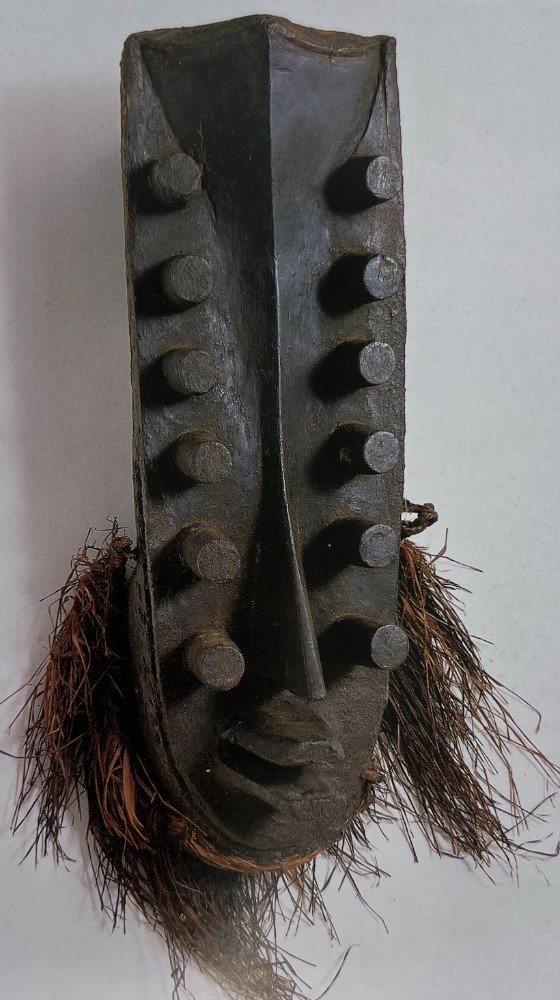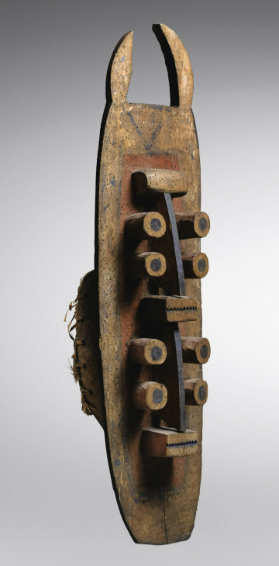Grebo/Kru Mask
Grebo/Kru Mask
Ivory Coast
Early 20th century
Wood, Metal. Height: 30.5 in
Price: $240,000
Description
The Grebo tribe historically occupied both coastal and inland areas around Cape Palmas on both sides of the border between Liberia and Ivory Coast. As part of a larger Kru linguistic group comprised of many smaller sub-groups or ethnicities, their artistic output has often been difficult to attribute specifically—those who generalize might say Grebo/Kru, while those trying to specify both time and place might refer to Grebo masks as Neyo or Godie. Initially lumped together as ‘Kru’ by colonists, the lack of differentiation from other groups is arguably a simplification or lack of understanding by outside observers.[1]
Nevertheless, the Grebo influenced and were influenced by surrounding peoples and their traditions, (most notably the We, and the Dan), creating an ongoing evolution of styles and a multiplicity of artistic forms. Three broad categories of Grebo mask can be observed: largely representational masks of an ideal woman, but often adorned with headdresses or horns; polychromatic masks with the proper number of facial features, but often exaggerated and fearsome; and the more abstract, monochromatic and serene “plank” masks, often with flat, sometimes elongated faces, vertical rows of tubular eyes and other anatomical anomalies.[2] Our example is this third type, a plank mask with many of the stylistic features of the type.
Although used for mainly secular purposes today and for collective entertainment as among the Godie and Neyo people of Ivory Coast,[3] they were previously used, according to Alain-Michel Boyer, to “expurgate those who are “doubles” (or souls, for Christians), but that it also played a part in settling ritual conflicts between clans, in the case of a land contest, a hunting problem or the rape of a woman. With its numerous eyes, it could “watch” the fighters, but also “strengthen” them, in order to raise them above their status as men and turn them into valiant warriors.”[4]
In Grebo mythology, ‘masks are gods among men.’ Quoting the Italian collector Mario Menghini, “in view of their essential function, which is to make sensible the invisible realm, masks are not complete in themselves but must be mounted on a straw structure and animated from inside by a human dancer. The ‘earthly heaven’ from which the masked figures come out is a particular area within the forest where the rituals and ceremonies take place. When masks are called to perform, it is either for ritual purposes to be seen only by initiates, or for entertaining people on particularly festive occasions. They are protected by various taboos, the transgressions of which are punishable by death” [5].
However, for Pierre Boutin, “the information we have (on these masks) is inversely proportional to their artistic fame. Contrary to other ethnic groups in south-western Cote D’Ivoire (We, Bete, Niabwa, etc.) {. . . } we know {. . .} nothing of their function—entertainment, funerary, initiatory, judicial, of the frequency of their appearances,--regular or exceptional--, nor the audience permitted to see them—open audience, extended or limited audience, with or without restriction regarding age or gender.”[6]
Our example is a plank mask and exhibits the abstraction of the facial features for which the Grebo masks are now famous—particularly for their influence on Picasso, who purportedly owned several such masks, and even featured one in a graphite sketch of his room in 1917. The protuberant multiple eyes may have evolved from a similar motif on intimidating war masks into a more spiritually significant meaning of an omnipotent seer, guardian or diviner. The upraised arms convey a feeling of protection; while their meaning is as yet unknown, it is an element of these masks known to outsiders at least since the collection of a similar mask by American missionary George A. Perkins, and donated to the Peabody Essex Museum in Salem, Mass. in 1859. In this case, the coloration is polychromatic but subdued. Separating the features by color, the arms nose and mouth are blackened, the eyes are white, and the face itself is light brown, with all surfaces showing signs of deep patina and age. Wear at the back is consistent with frequent usage. Four holes on the chin suggest an original beard of raffia.
Footnotes
[1] McEvoy, Frederick D. “Understanding Ethnic Realities among the Grebo and Kru Peoples of West Africa,” Africa: Journal of the International African Institute 47, no. 1 (1977): 62–80.
[2] Adams, Monni in Phillips, Tom, ed. Africa : The Art of a Continent. London: Prestel, 1996. 465.
[3] Boutin, Pierre. “Les masques ‘Krou’ de Côte-d’Ivoire,” Afrique : Archéologie & Arts 5 (2007-2009), 7-26.
[4] Boyer, Alain-Michel, “Between the Seen and the Unseen.” In Arts d’Afrique et d'Océanie: Live Auction PF1718 in Paris, 12 December 2017, by Sotheby’s. Lot 50.
[5] Meneghini, Mario. “The Grebo Mask,” African Arts 8 (1) (1974): 36–39.
[6] Boutin, Pierre. “Les masques ‘Krou’ de Côte-d’Ivoire,” Afrique : Archéologie & Arts 5 (2007-2009), 7-26.
Sotheby’s
Masque, Grebo / Krou
Liberia / Côte d'Ivoire
Arts d'Afrique et d'Océanie: Live Auction PF1718 12 December 2017, Paris. Lot 50.
Auction Estimate: 700,000 - 1,000,000 EUR
(Photo: Sotheby's)
Sotheby’s
Masque, Grebo / Krou
Liberia / Côte d'Ivoire
The Saul and Marsha Stanoff Collection: Live Auction N08386 17 May 2007, New York. Lot 19.
Auction Estimate: 600,000 - 900,000 USD
Realized Price: 768,000 USD
(Photo: Sotheby's)
Grebo. Mask.
Grebo, probably Cape Palmas area, Liberia.
19th century
Wood, ceramic, iron, nails, pigment.
Peabody Essex Museum, Salem, Massachusetts.
(Photo: Wells, Louis T. “Art and Expatriates in Liberia.” Tribal Art: Quarterly Journal of the Art, Culture and History of Traditional Peoples and New World Civilizations 14 (2), no. 55 (Spring 2010): 107.)

Kru. Many-eyed mask.
Ivory Coast
20th century
Wood, vegetable fibre
Musée Ethnographique de Dakar.
(Photo: Phillips, Tom, ed. Africa : The Art of a Continent. London: Prestel, 1996. 465.)
Condition
Raffia headdress for attachment to the head/face is intact and in excellent condition.
Adams, Monni, “Many-Eyed Mask,” in Africa: The Art of a Continent. Edited by Thomas Phillips. London: Prestel, 1996. 465.
Boutin, Pierre. “Les masques ‘Krou’ de Côte-d’Ivoire.” Afrique : Archéologie & Arts 5 (2007-2009): 7–26. https://doi.org/10.4000/aaa.767.
Boyer, Alain-Michel, “Between the Seen and the Unseen.” In Arts d’Afrique et d'Océanie: Live Auction PF1718 in Paris, 12 December 2017, by Sotheby’s. Lot 50. https://www.sothebys.com/en/auctions/ecatalogue/2016/arts-afrique-oceanie-pf1718/lot.50.html
Daix, Pierre. Picasso: L African. Edited by Jean Paul Barbier. Geneva: Musée Barbier-Mueller, 1998. https://www.abebooks.com/Picasso-African-Pierre-Daix/30567606246/bd.
McEvoy, Frederick D. “Understanding Ethnic Realities among the Grebo and Kru Peoples of West Africa.” Africa: Journal of the International African Institute 47, no. 1 (1977): 62–80. https://doi.org/10.2307/1159195.
Meneghini, Mario. “The Grebo Mask.” African Arts 8 (1) (1974): 36–87. https://doi.org/10.2307/3334919.
Phillips, Tom, ed. Africa : The Art of a Continent. London: Prestel, 1996.
Robbins, Warren M., and Nancy Ingram Nooter. African Art in American Collections. Washington and London: Smithsonian Institution Press, 1989.
Schädler, Karl-Ferdinand. Encyclopedia of African Art and Culture. Munich: Panterra, 2009.
Schmalenbach, Werner, ed. African Art: From the Barbier-Mueller Collection. Munich: Prestel, 1988.
Sotheby’s. Arts d’Afrique et d'Océanie: Live Auction PF1718 in Paris, 12 December 2017. (Paris: Sotheby’s. 2019). https://www.sothebys.com/en/auctions/2016/arts-afrique-oceanie-pf1718.html?locale=en
Stepan, Peter. Picasso’s Collection of African & Oceanic Art: Masters of Metamorphosis. Munich: Prestel, 2006.
Visona, Monica Blackmun, Robin Poynor, Herbert M. Cole, Michael D. Harris, Rowland Abiodun, and Suzanne Preston Blier. A History of Art in Africa. New York: Prentice Hall/Harry N. Abrams, 2000.
Wells, Louis T. “Art and Expatriates in Liberia.” Tribal Art: Quarterly Journal of the Art Culture and History of Traditional Peoples and New World Civilizations 14 (2), no. 55 (Spring 2010): 96–111.



